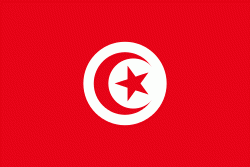Aïn Draham (Ain Draham)
Aïn Draham (عين دراهم ) is a city in northwestern Tunisia in the Jendouba Governorate, situated 25 kilometers south of Tabarka near the border with Algeria. Historically a military outpost, summer resort and souq, today it is a regional economic hub.
The city is the capital of a delegation of 40,372 inhabitants. The city itself has an estimated population of 10,843 inhabitants (according to the census of 2004). It is located at an altitude of 800 meters on the slopes of the Djebel Bir (1014 m), one of the Kroumirie mountains. The city is located in one of the most humid areas of Tunisia and holds the record for the highest average rainfall at 1534 mm per year. Rainfalls are one of the major factors influencing landslides, often occurring in this area.
Its name describes the sulfurous hot springs in the area used by the Romans in antiquity. Ruins of Roman baths are also found in the area.
Aïn Draham was originally a French military base
In 1930, it became a multi-purpose tourist resort intended to retain the French colonists guesthouse, residences, administrative tourism, etc.). The forest situation of the city and its colonial heritage (architecture, tile s reds and Tunisian crafts offers it advantages for interior tourism: thermal comfort summer, a wealth game, in particular in wild boar s, hiking, equestrian or MTB trails, green tourism and sports and the hydrotherapy.
The city is the capital of a delegation of 40,372 inhabitants. The city itself has an estimated population of 10,843 inhabitants (according to the census of 2004). It is located at an altitude of 800 meters on the slopes of the Djebel Bir (1014 m), one of the Kroumirie mountains. The city is located in one of the most humid areas of Tunisia and holds the record for the highest average rainfall at 1534 mm per year. Rainfalls are one of the major factors influencing landslides, often occurring in this area.
Its name describes the sulfurous hot springs in the area used by the Romans in antiquity. Ruins of Roman baths are also found in the area.
Aïn Draham was originally a French military base
In 1930, it became a multi-purpose tourist resort intended to retain the French colonists guesthouse, residences, administrative tourism, etc.). The forest situation of the city and its colonial heritage (architecture, tile s reds and Tunisian crafts offers it advantages for interior tourism: thermal comfort summer, a wealth game, in particular in wild boar s, hiking, equestrian or MTB trails, green tourism and sports and the hydrotherapy.
Map - Aïn Draham (Ain Draham)
Map
Country - Tunisia
 |
 |
| Flag of Tunisia | |
Beginning in early antiquity, Tunisia was inhabited by the indigenous Berbers. Phoenicians began to arrive in the 12th century BC, establishing several settlements, of which Carthage emerged as the most powerful by the 7th century BC. Carthage was a major mercantile empire and a military rival to the Roman Republic until 146 BC, when it was defeated by the Romans who occupied Tunisia for most of the next 800 years. The Romans introduced Christianity and left architectural legacies like the Amphitheatre of El Jem. In the 7th century AD, Arab Muslims conquered all of Tunisia (finally succeeding in 697 after several attempts starting in 647) and settled with their tribes and families, brought Islam and Arab culture to the local inhabitants, and since then Arabs became the majority of the population. Then, in 1546, the Ottoman Empire established control there, holding sway for over 300 years, until 1881, when the French conquered Tunisia. In 1956, Tunisia gained independence as the Tunisian Republic under the leadership of Habib Bourguiba with the help of activists such as Chedly Kallala, Farhat Hached and Salah Ben Youssef. Today, Tunisia's culture and identity are rooted in this centuries-long intersection of different cultures and ethnicities.
Currency / Language
| ISO | Currency | Symbol | Significant figures |
|---|---|---|---|
| TND | Tunisian dinar | دت | 3 |
| ISO | Language |
|---|---|
| AR | Arabic language |
| FR | French language |















